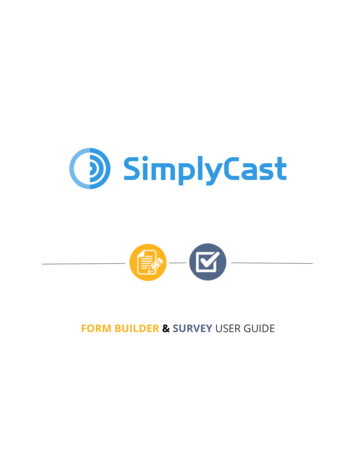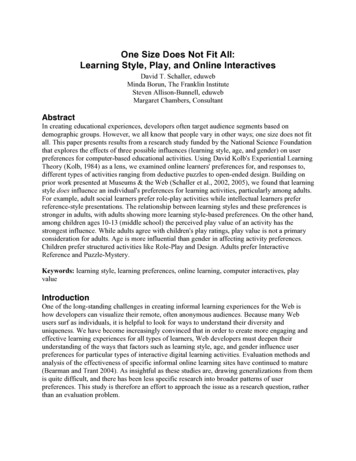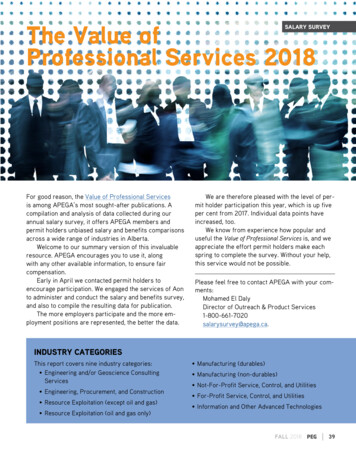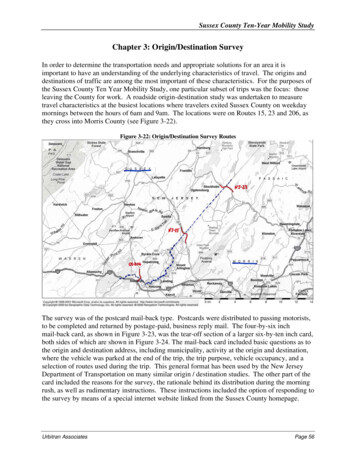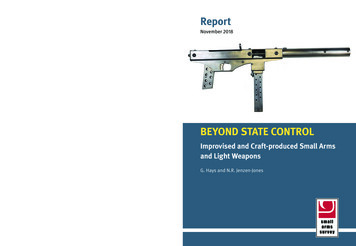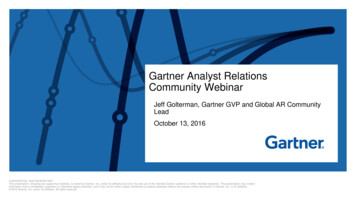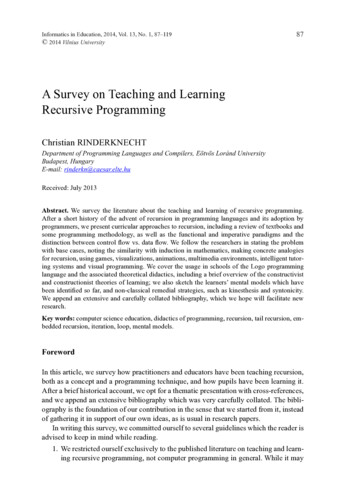
Transcription
Informatics in Education, 2014, Vol. 13, No. 1, 87–119 2014 Vilnius University87A Survey on Teaching and LearningRecursive ProgrammingChristian RINDERKNECHTDepartment of Programming Languages and Compilers, Eötvös Loránd UniversityBudapest, HungaryE-mail: rinderkn@caesar.elte.huReceived: July 2013Abstract. We survey the literature about the teaching and learning of recursive programming.After a short history of the advent of recursion in programming languages and its adoption byprogrammers, we present curricular approaches to recursion, including a review of textbooks andsome programming methodology, as well as the functional and imperative paradigms and thedistinction between control flow vs. data flow. We follow the researchers in stating the problemwith base cases, noting the similarity with induction in mathematics, making concrete analogiesfor recursion, using games, visualizations, animations, multimedia environments, intelligent tutoring systems and visual programming. We cover the usage in schools of the Logo programminglanguage and the associated theoretical didactics, including a brief overview of the constructivistand constructionist theories of learning; we also sketch the learners’ mental models which havebeen identified so far, and non-classical remedial strategies, such as kinesthesis and syntonicity.We append an extensive and carefully collated bibliography, which we hope will facilitate newresearch.Key words: computer science education, didactics of programming, recursion, tail recursion, embedded recursion, iteration, loop, mental models.ForewordIn this article, we survey how practitioners and educators have been teaching recursion,both as a concept and a programming technique, and how pupils have been learning it.After a brief historical account, we opt for a thematic presentation with cross-references,and we append an extensive bibliography which was very carefully collated. The bibliography is the foundation of our contribution in the sense that we started from it, insteadof gathering it in support of our own ideas, as is usual in research papers.In writing this survey, we committed ourself to several guidelines which the reader isadvised to keep in mind while reading.1. We restricted ourself exclusively to the published literature on teaching and learning recursive programming, not computer programming in general. While it may
88C. Rinderknecht2.3.4.5.be argued that, for example, articles and books about functional programmingalmost constantly make use of recursion, we preferred to focus on the papers presenting didactical issues explicitly and exclusively related to recursion.We did not review the emergence of the concept of recursion from its mathematical roots, and we paint a historical account with our fingers, just enough to addressthe main issues of this survey with a minimal background information.We did not want to mix our personal opinion and assessment of the literature withits description, because we wanted this article to be in effect a thematic index tothe literature, even though it is not possible to cite all references in the text, forroom’s sake. The only places where we explicitly express our own ideas are in ourown publications, in the definitions found in the introduction (in the absence ofbibliographic reference) and in the conclusion.We did not cover topics like the teaching of recursion and co-recursion in the context of lazy evaluation, or programming languages based on process algebras ordataflow, because they have not been addressed specifically in didactics publications, perhaps because they are advanced topics usually best suited for postgraduate students, who are expected to master recursion, and most publications dealwith undergraduates or younger learners.Despite our best efforts in structuring the ideas found in the literature, the following presentation contains some measure of repetition because papers often covermutually related topics, so a printed survey cannot capture exactly what is actuallya semantic graph, and such a graph would better support a meta-analysis of theliterature (where cross-referencing, publication timelines, experimental protocolsand statistics would be in scope) rather than a survey.IntroductionIn abstract terms, a definition is recursive if it is self-referential. For instance, in programming languages, function definitions may be recursive, and type definitions as well.Give’on (1990) provided an insightful discussion of the didactical issues involved in thedifferent meanings ascribed to the word, which appeared first in print by Robert Boylein 1660 (New Experiments Physico-Mechanicall, chap. XXVI, p. 203) to qualify themovement of a moving pendulum, which returns or “runs back”. (Beware the incorrectand ominous “to recurse”.)A short history. Formal definitions based on recursion played an important role in thefoundation of arithmetic (Peano, 1976) and constructive mathematics (Skolem, 1976,Robinson, 1947, 1948), as well as in the nascent theories of computability (Soare, 1996,Oudheusden, 2009, Daylight, 2010, Lobina Bona, 2012), with the caveat that recursiontheory is only named so for historical reasons. The first computers were programmed inassembly languages and machine codes (Knuth, 1996), but the first step towards recursion is the advent of labelled subroutines and hardware stacks, by the end of the 1950s.BASIC epitomises an early attempt at lifting these features into a language more abstractthan assembly: recursion is simulated by explicitly pushing (GOSUB) program pointers
A Survey on Teaching and Learning Recursive Programming89(line numbers) on the (implicit) control stack, and by popping (RETURN) them. According to the definition above, this is not recursion, which is to be understood as beingpurely syntactic (a function definition), not semantic (the evaluation of an expression).Moreover, the lack of local scoping precludes passing parameters recursively. Nevertheless, “recursion” has been taught with BASIC by Daykin (1974).With even more abstract programming languages, fully-fledged recursion becamea design option, first advocated in print by Dijkstra (1960) and McCarthy (1960), andimplemented in LISP, ALGOL, PL/I and Logo (Martin, 1985, Lavallade, 1985), withthe notable exceptions of Fortran and COBOL. Formal logic was then used to ascribemeanings to programs, some semantics relying on recursion, like rewrite systems, someothers not, like set theory or λ-calculus (where recursion is simulated with fixed-pointcombinators). Even though the opinion of Dijkstra (1974) (1975) varied, recursionproved a powerful means for expressing algorithms (Dijkstra, 1999) (Reingold, 2012),especially on recursive data structures like lists, i.e., stacks, and trees. With the legacyof LISP and ALGOL, together with the rise and spread of personal computers, recursionbecame a common feature of modern programming languages, and arguably an essentialone (Papert, 1980, Ford, 1982, Astrachan, 1994).1. Recursion, Iteration and LoopsRecursion is often not clearly understood, as demonstrated by the frequent heated ormisguided discussions on internet forums, in particular about the optimisation of tailcalls. Moreover, some researchers implicitly equate loop and iteration, use the expression “iterative loop”, or call recursion a process implemented by means of a controlstack, whilst others use a syntactic criterion.We must define recursion in order to relateit to other concepts, like loops, iteration, tail recursion, embedded recursion, structuralrecursion etc.Definitions. Give’on (1990) remarked: “the concept of recursion is being vaguely andinconsistently constructed from some syntactical properties of the program, from its associated semantics and from features borrowed from models of execution of programs”.Indeed, broadly speaking, there are two angles to approach the question: the static (syntactic) approach and the dynamic approach to recursion. Sometimes the dichotomy is putin terms of programs (structured texts or abstract syntax trees) versus processes (autonomous agents or stateful actors). In fact, to address the vast literature about the teachingand learning of recursion, it is essential to understand both views and their relationship.In the static comprehension, recursion is restricted to the general definition we gaveat the start of this introduction: the occurrence of the symbol being defined inside itsdefinition (what is called impredicativity in logic). Implicitly, this means of course thatit must be clear what the denotation of the occurring symbol is, in order to determinewhether it is an instance of the definition. For example, in the language OCaml, the function definitionlet rec f x (fun - x) f
90C. Rinderknechtis recursive because the name f in the right-hand side refers to the f in the left-handside. Note that there is no call to f in the definition of f, so the concept of recursivecall is actually irrelevant: recursion in this context is a property of definitions based onlexical scoping rules, not of the objects potentially computed (values), nor the way theyare computed (semantics). In particular, the recursive definition of a function does notnecessarily entails that it is total, hence terminates for all inputs. (A type system mayenforce that property, as in Coq or Agda.) Sometimes, an examination of the programcannot determine whether the occurrence of a symbol refers to the definition at hand. Forinstance, let us consider the following fragment of Java:public class T { public void g(T t) { . t.g(t); . } }The occurrence of g in the expression t.g(t) does not necessarily refers to the current definition of the method g, because that method may be overridden in subclasses.Therefore, here, we cannot conclude that g is recursive according to the static criterion.(It can be argued, though, that the class T is recursive because its definition includes thedeclaration (type) of its method g, where T occurs – Interfaces perhaps illustrate thisbetter.)The dynamic comprehension of recursive functions can be expressed abstractly asa property about dynamic call graphs: recursion is a reachable cycle, which means, inoperational terms, that the control flow of calls returns to a vertex (a function) whichwas previously called. Here, the notion of recursive definition is not central, and it makessense to speak of recursive call (a back edge closing a path). Another, less general, approach to a dynamic definition of recursion relies on a particular execution model, oftenbased on stack frames allocated to function calls and their lexical context. Anyway, as aproperty about the control flow, recursion in that sense becomes undecidable in generalfor Turing-complete languages.It should be noted that the static and dynamic definitions of recursion may overlap,but are different in general, that is, if a function is recursive according to the syntacticcriterion, it may not be recursive according to the dynamic criterion (as the above OCamlfunction f illustrates), and vice versa. Consider the following OCaml program implementing the factorial function:# let pre selfval pre : (int# let rec factval fact : int# fact 5;;- : int 120n if n 0 then 1 else n * self(n-1);;- int) - int - int fun n pre fact n;;- int fun The syntactic criterion decides that pre is not recursive and fact is; the dynamiccriterion sees these two functions as mutually recursive, that is, the control flow goesfrom one to the other, and vice versa. Furthermore, there are different techniques toachieve dynamic recursion without static recursion at all. For example, using fixed-pointcombinators in OCaml with the command-line option –rectypes:
A Survey on Teaching and Learning Recursive Programming91# let pre self n if n 0 then 1 else n * self(n-1);;val pre : (int - int) - int - int fun # let y f (fun x a - f (x x) a) (fun x a - f (x x) a);;val y : ((’a - ’b) - ’a - ’b) - ’a - ’b fun # let fact y pre;;val fact : int - int fun # fact 5;;- : int 120Here, neither the higher-order function y (called the call-by-value Y combinator),nor the function pre are statically recursive (as the absence of the keyword rec showswell), but they are mutually recursive in the dynamic sense. (The rationale behind thedefinition of y is obscure, but relies on the fact that (y f) x yields the computation of(f(y f)) x, showing that y f is the fixed point of f.) It is even possible to definethe factorial function without recursion, loops or jumps (goto) in C, but the program iscryptic:#include stdio.h #include stdlib.h typedef int (*fp)();int fact(fp f, int n) {return n? n * ((int (*)(fp,int))f)(f,n-1) : 1; }int read(int dec, char arg[]) {return (’0’ *arg && *arg ’9’)?read(10*dec (*arg - ’0’),arg 1) : dec; }int main(int argc, char** argv) {if (argc 2) e printf(“Only one integer allowed.\n”);return 0; }(See Goldberg and Wiener (2009) for a practical use of such a simulated recursionin Erlang.) References can also be used to define the factorial function without staticrecursion, with a technique called Landin’s knot:# let g ref (fun n - 42);;val g : (’ a - int) ref {contents fun }# let f n if n 0 then 1 else n * !g(n-1);;val f : int - int fun # let fact g : f; fun n - !g(n);;val fact : int - int fun # fact 5;;- : int 120
92C. RinderknechtHere, none of the definitions are statically recursive, although f is dynamically recursive.Finally, it is perhaps worth insisting on the case where there are more than onedefinition, like ( ) : ( – 1) and ( ) : ( 1 ( – 1)). Neither definition is statically recursive, although they are mutually recursive according to the dynamic interpretation. Furthermore, it is clear that these definitions are equivalent to ( ) : ( ( – 2)), which is statically recursive. This shows that the concept ofmutual recursion is dynamic, but the static criterion could be extended to apply transitively to the static call graph, which is an over-approximation of the dynamic call graph,so we can speak of mutual recursion in a static sense as well, but keeping in mind thatthere can be mutual recursion statically when there is none dynamically.Tail recursion, iteration and loops. The concept of tail recursion is difficult to apprehend because it is built upon both the dynamic call graph and the data flow. We havealready seen that recursion can be defined as a cycle in the dynamic call graph. Here,we define the dataflow graph as the dynamic call graph with an additional kind of edgesoriented according to the direction where the data flows (it is a multigraph): if a callerpasses arguments to the callee, there is a data edge doubling the control edge; if the valueof a function call is needed to further compute an expression or complete an instruction,there is a data edge from the callee to the caller, that is, a backward data edge with respectto the control edge. Since, in the absence of run-time errors, the result of a call is needed,at the very least, to stand for the result of the caller itself, there is always a back edge.Therefore, we could make those edges implicit and only retain them when the value ofthe call is needed in a strictly embedding expression, not just to be returned in turn. Tailrecursion is then a cycle along the control edges, which is not a retrograde cycle followingthe data edges. In other words, the data flows solely in the same direction as the controlflows. (Note that, in general, there may be no data flow between two calls.)For instance, the value of the recursive call in ( ) : ( ( )) is the value of ( ) being defined, so the call is tail recursive. On the other hand, the value of thecall ( – 1) in ( ) : f ( – 1) is not the value of the call ( ) being definedbecause a multiplication by is pending, so it is not tail recursive. The same holds for ( ) : ( ( – 1)). Note that, within the dynamic interpretation of recursion, theconcept of tail recursion applies to function calls, not to function definitions as a whole,so it is technically incorrect to say that a function definition is tail recursive.Within the static understanding of recursion, it is not possible to define tail recursionin general because only definitions may be recursive and only calls may be in tail position. The latter refers to a syntactic criterion which implies that the value of a call is onlyused to become the value of the current function being called. In practice, however, itis possible to speak of a tail recursive call when the static and dynamic interpretationsagree, that is, when a definition includes non-ambiguously a call to the function defined(a special case of static recursion) and that call is in tail position. Nevertheless, sincethe very reason to distinguish tail recursive calls is that they can often be compiled asefficiently as loops are (a technique known as tail call optimisation), the interactionbetween the control flow and the data flow must be made explicit anyway, even withina static framework, and this proves challenging to students and professors alike. Even
A Survey on Teaching and Learning Recursive Programming93more puzzling is the fact that the optimisation applies to non-recursive calls as well, aslong as they are in tail position.When a recursive call is not tail recursive, it is sometimes called an instance of embedded recursion. In theory, it is always possible to rewrite any embedded recursion intotail recursion, but the result can be rather hard to understand, hence difficult to designdirectly. Moreover, in programming languages featuring conditional loops (while), recursion can be avoided in theory, but, in practice, many algorithms are expressed morecompactly or more legibly if recursive. A loop is a segment of code syntactically distinguished and whose evaluation is repeated until a condition on the state of the memory ismet. The syntactic condition, e.g., a keyword and markers for a block, is meant to differentiate loops from source code whose control flow relies on jumps (goto) and couldactually be an unstructured implementation of loops (using backward jumps), but are notloops. Iteration is none other than the concept of repetition applied to a piece of sourcecode, therefore, from a theoretical standpoint, it should include recursion and loops, but,in practice, iteration is often used as a synonym for the execution of a loop in an imperative language (looping); in a purely functional language, iteration is tail recursion.Conditional loops (while) and recursion have the same expressive power, so using oneform or the other is a matter of style as long as side-effects are allowed, because loopsrequire a model of computation where data is mutable.As we mentioned earlier, some researchers prefer to define recursion not on programs, but on processes, that is, on the dynamic interpretation of programs. For instance, Kahney (1983) defines recursion as a process “that is capable of triggering newinstantiations of itself, with control passing forward to successive instantiations andback from terminated ones.” Of course, one data structure suitable for implementingthis mechanism is the control stack, which we already mentioned about “recursion inBASIC” (Daykin, 1974). It is perhaps interesting to notice the use of the “forward” and“backward” terminology about the control flow on the call graph, although that graph isoriented from callers to callees and there are no back edges because these would not denote calls but returns. (Our own definition of dynamic recursion is a cycle in the dynamiccall graph, where “backward” qualifies the data flow superimposed on the call graph.)We will see in a forthcoming section that this operational interpretation of recursioncan be suitably exploited by kinesthetic teaching. The sections on analogies and mentalmodels also revisit this choice. Finally, when contrasting the static (syntactic) and dynamic (control stack) definitions, it is worth keeping in mind that it is possible to compile recursive definitions of functions in such a way that the size of the control stack isstatically bounded; in other words, recursion can always be transformed into iteration.Teaching. Clearly, recursion and loops are not mutually exclusive and may serve thesame purpose, which often bewilders the beginner. Consequently, a simple attempt at aremedy consists in clearly separating the different concepts at stake in the evaluation ofa program (Velázquez-Iturbide, 2000), so that side-effects, for instance, do not get in theway of learning recursion declaratively. To teach the difference between iteration andembedded recursion, some researchers have proposed to teach how to translate an embedded recursive definition into an iteration, while remaining in the same programming language (Augenstein and Tenenbaum, 1976, Rubio-Sánchez and Velázquez-Iturbide, 2009,
94C. RinderknechtRubio-Sánchez, 2010, Rinderknecht, 2012). Foltynowicz (2007) went even further byderiving loops from embedded recursion, and vice versa, which is of great theoretical andpractical interest, in particular for understanding compilers and interpreters. By exhibiting a systematic way to move back and forth from recursion to loops, while maintainingthe meaning invariant, these didactic approaches aim at demystifying recursion withoutresorting to a low-level view of evaluation with the control stack.Finite iteration is unidirectional in the sense that the control flow does not return toa previous program location where the environment, i.e., the bindings of the variablesto their values, is the same. Embedded recursion is often called bidirectional when itis based on the strict interpretation of the composition of functions, as opposed to anon-strict semantics, like lazy evaluation, which is perhaps better explained by graphrewriting. Consider for instance ( ( )), where is a value. First, the value of ( ) iscomputed (control and data flow forward), that value is bound to an implicit variable (control and data flow back) and then the call ( ) is evaluated (control and data flowforward).Finally, let us take note of a radical and contrarian view: to avoid recursion as muchas possible (Anonymous, 1977, Buneman and Levy, 1980). For instance, Harvey (1992)advocates the use of a functional style where recursion is hidden inside higher-orderfunctions like maps and folds. This is indeed the approach often taken when teachingpurely functional programming languages, especially those with a non-strict semanticslike Miranda or Haskell.2. Functional ProgrammingSegal (1994) notes that, in the context of the functional programming language Miranda, “by using the library of functions as a toolbox, recursion, the underlying structureof many of the functions and the only repetitive construct provided by the language,can remain largely hidden.” Er (1984) argued that recursion is made difficult by blockstructured programming languages, which suggests that one way of encouraging the useof desirable constructs, like recursion, would be to employ or develop domain-specificlanguages (Sinha and Vessey, 1992); cf. Brooks et al. (1992). It would then make senseto teach recursion with functional languages, because these feature prominently mathematical functions and immutable data, forcing the programmer to think recursively(Henderson and Romero, 1989, Howland, 1998).Because it is possible, for the purpose of teaching, to define a semantics for functional languages based on term or graph rewriting, Velázquez-Iturbide (1999), Pareja-Floreset al. (2007) and Rinderknecht (2012) can ask learners to trace by hand the evaluationof their small programs. Segal (1994) remarks that “we would argue [.] that the abilityto be able to evaluate a recursive function mentally or ‘by hand’ (that is, independent ofa machine), is an essential component of recursive knowledge for both learners and experts.” In the case of teaching higher-order functions, using manual reductions is also arecommendation of Clack and Myers (1995), who also list a long series of typical errorsand their analysis. Furthermore, Burton (1995) observes that
A Survey on Teaching and Learning Recursive Programming95perhaps students are puzzled, unnecessarily, by the the language (I refer tonatural language here) with which we talk to them about recursion. PeterLandin is fond of pointing out the numerous inconsistencies with which suchlanguage is riddled (the phrase “calls itself ”, for instance, probably elidesall kinds of different semantic levels). An advantage of teaching via reduction sequences is that it enables us to take the (natural) language out – justreduce, reduce, reduce (perhaps with the aid of a machine).He also recommends what he calls a “separation of concerns” in teaching at first listprocessing, pattern matching and recursion in isolation: this avoids the issue for the students to assimilate recursion at the same time as other imperfectly understood concepts.Velázquez-Iturbide (1999) also relies on term rewriting to teach recursion before movingto recursion in an imperative language with recursive data types. By writing down therewrite system in the exact order of a top-down design, students become accustomed tolaying out calls to functions yet to be defined; by also asking them to write down all theleft-hand sides of the rules (patterns) before proceeding to the right-hand sides in random order, not only completeness is improved, but also the conception of a program as atext written in one pass is undermined, and the model of a form or a blueprint is proposedinstead. This twofold method seems to defuse a bit the typical question of a recursivecall (right-hand side) to the current function “still under construction”, because at leastall the configurations of the input (left-hand side) have been already laid out and it is alsonormal to call yet undefined functions, just like it is normal to have pending referencesin a map being drawn to other parts yet to be filled. This view seems to be one of theconclusions of Vitale (1989), when he writes, in abstract terms:It is proposed that a restricted notion of “recursion” could be usefully defined, entailing:1. that the attitude of the subject, with respect to the definition of a notion,the solution of a problem, the answer to a question, etc., should contain ameasure of suspended attention, deferring in a way the final restructuringof the definition solution, answer, etc., to the completion of a downwardand then upward spiralling path;2. that the spiralling path should be describable by the dialectical coexistence of permanence (the path, global because relying on the various steps)and change (the pitch of the spiral, local because defined – and possiblychanging – at every turn).(For some technical corrections on the article of Vitale (1989) and some contexton the relevance of recursion in the cognitive sciences and artificial intelligence, seethe follow-ups by Trautteur (1989) and Apostel (1991), as well as Kieren (1989) in thecontext of Logo.) Furthermore, by using directed acyclic graphs to represent programsand data, instead of abstract syntax trees, aliasing (data sharing) becomes visible and thecontrol stack and heap can arise from this model without resorting to low-level descriptions (Rinderknecht, 2012).Another approach, advocated by Felleisen et al. (2001), consists in systematicallystarting with the definition of recursive data types, because such types already suggest
96C. Rinderknechtthe recursive structure of the function definition to process their values. We will revisitthis method when presenting structural recursion. Pirolli (1986) showed that focusingthe teaching of recursion on the structure of the function definition is more effective thaninsisting on the evaluation process, with traces of the control and data flows.When loops are taught after recursion in a functional language, no transfer of skillsseems to be observed, undermining the idea that iteration is inherently simpler than recursion (Mirolo, 2011). For an equivalent study with logic programming in Prolog, seeHaberman (2004). Moreover, simple functional programs on lists can be translated systematically in Java (Rinderknecht, 2012), following design patterns similar to those byFelleisen and Friedman (1997), Bloch (2003) and Sher (2004). The programs which arederived are in static single assignment form and eschew the null from Pandora’s vase(Cobbe, 2008, Hoare, 2009). However, Segal (1994), Clack and Myers (1995) noted thatinducing students to think recursively with functional languages may yield some of theproblems encountered with imperative languages, and Paz and Lapidot (2004) showedhow prior experience with imperative programming influences the learning of functionalprogramming. This brings us to examine when is recursion taught.3. Curricular ApproachesThe scheduling of the teaching of recursion in school curriculums has long been debated(Olson, 1987, Barfurth and Retschitzki, 1987, Greer, 1989). For example, Zmuda andHatch (2007) compare two approaches: the scheduling of consecutive units of teachingon recursion versus the intermittent teaching of recursion, whereby two units about recursion are separated by a different topic.Secondary schools. In many countries, programming literacy, as opposed to vocational training on software products (e.g., ICT in the United Kingdom since the 1990s),is still absent in the secondary schools curriculums. For instance, the French government officially introduced it only in July 2011, as an option for science majors, andrecursion is not even mentioned in the new regulation, whose implementation startedin September 2012. (The mathematics curriculum contains only one paragraph aboutalgorithms, which must be explicitly iterative (Modeste, 2012).) Wherever program
With even more abstract programming languages, fully-fledged recursion became a design option, first advocated in print by Dijkstra (1960) and McCarthy (1960), and implemented in LISP, ALGOL, PL/I and Logo (Martin, 1985, Lavallade, 1985), with the notable exceptions of Fortran and COBO
